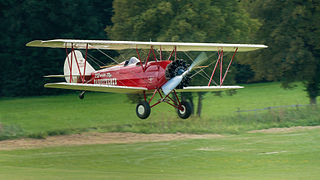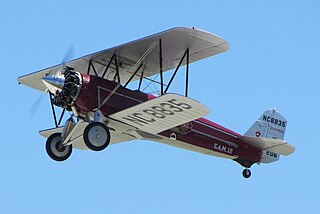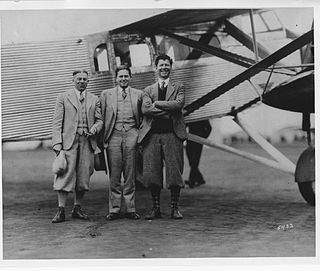 | |
| Industry | Aerospace |
|---|---|
| Founded | 1923 |
| Founder | Emil Matthew Laird |
| Headquarters | , United States |

E. M. Laird Airplane Company was an American aircraft manufacturer of commercial aircraft and custom race planes. [1]
 | |
| Industry | Aerospace |
|---|---|
| Founded | 1923 |
| Founder | Emil Matthew Laird |
| Headquarters | , United States |

E. M. Laird Airplane Company was an American aircraft manufacturer of commercial aircraft and custom race planes. [1]

Emil Matthew Laird partnered with the founders of the Wichita Airplane Company to build a new commercial biplane aircraft in 1920. The E.M Laird Company built 45 Swallow aircraft of this design. The company turned down an offer to move to Monmouth, Illinois in 1922. [2] E.M Laird sold all rights on 27 September 1923 to J. M Mollendick, and formed a new company, the E. M. Laird Airplane Company based out of Chicago. [3] The original E. M. Laird Company then became the Swallow Airplane Company, retaining brother Charles Laird. Charles Laird concurrently started a short lived aircraft company named Laird Aircraft Corporation, publicly known as Whipporwhill in order to differentiate himself from Emil. [4]
The E.M. Laird Aircraft company returned to Laird's hometown, building facilities at Ashburn Field, in Ashburn, Chicago. By 1928, Laird's aircraft had reached a level quality and competition, that the Stout Metal Airplane Division of the Ford Motor Company offered to hire Laird, and purchase all the assets of his company. [5]
| Model name | First flight | Number built | Type |
|---|---|---|---|
| Laird LC-B | 11+ | Single engine open cockpit utility biplane | |
| Laird LC-R | 2+ | Single engine open cockpit utility biplane | |
| Laird LC-AA | 1 | Single engine cabin utility biplane [6] | |
| Laird LC-DC | 2 or 3 | Single engine open cockpit racing monoplane [6] | |
| Laird LC-DE Speedwing Junior | 1930 | 1 | Single engine open cockpit racing monoplane |
| Laird LC-DW Solution | 1930 | 1 | Single engine open cockpit racing biplane |
| Laird LC-DW500 Super Solution | 1931 | 1 | Single engine open cockpit racing biplane |
| Laird LC-RW | 1931 | 2 | Single engine open cockpit racing biplane [7] |
| Laird LC-EW | 1 | Single engine cabin utility monoplane | |
| Laird LC-1B | 1930 | 11+ | Single engine open cockpit utility biplane [8] |
| Laird-Turner Meteor LTR-14 (modifications) | 1936 | 1 | Single engine cabin racing monoplane |

The Ford Reliability Tour, properly called "The National Air Tour for the Edsel B. Ford Reliability Trophy", was a series of aerial tours sponsored in part by Ford from 1925 to 1931 and re-created in 2003. Top prize was the Edsel Ford Reliability Trophy. Henry and Edsel Ford were shareholders in the Stout Engineering Company. In August 1925, they purchased the entire company, making it the Stout Metal Airplane Division of the Ford Motor Company. Their product, the Stout 2-AT Pullman, was a featured plane. The plane was also used by their new airline the Ford Air Transport Service, which started regular flights in April. The flights out of Ford Airport (Dearborn) cross-marketed, and showcased Ford's new interest in aviation.

The Travel Air 2000/3000/4000 (originally, the Model A, Model B and Model BH were open-cockpit biplane aircraft produced in the United States in the late 1920s by the Travel Air Manufacturing Company. During the period from 1924–1929, Travel Air produced more aircraft than any other American manufacturer, including over 1,000 biplanes. While an exact number is almost impossible to ascertain due to the number of conversions and rebuilds, some estimates for Travel Air as a whole range from 1,200 to nearly 2,000 aircraft.

The Swallow Airplane Company was an early manufacturer of airplanes.

The Stearman C3 was an American-built civil biplane aircraft of the 1920s, designed by Stearman Aircraft of Wichita, Kansas. It was also the first Stearman aircraft to receive a type certificate.

The Stout Skycar was a series of four one-off American light aircraft of the 1930s.

The Swallow Airplane Swallow is an American-built general purpose biplane of the mid- to late 1920s.

Stout Metal Airplane Division of the Ford Motor Company was an American aircraft manufacturer founded by William Bushnell Stout as the Stout Metal Airplane Co. in 1922. The company was purchased by Ford Motor Company in 1924 and later produced the Ford Trimotor. At the height of the Great Depression, Ford closed the aircraft design and production division in 1936, temporarily re-entering the aviation market with the production of the B-24, at the Willow Run aircraft factory during World War II.

The Stout 2-AT Pullman, or "Air Pullman", was a single engine all-metal monoplane that was used for early airline travel and air mail transport in America.

George Henry Prudden, Jr. was an American aircraft engineer. He was instrumental in designing the first all metal aircraft in America. He was president of the Early Birds of Aviation in 1961.
Victor H. Roos was an American entrepreneur and the founder or co-founder of several early aircraft companies, including Cessna Aircraft.

Dallas Spirit,, was a custom-built aircraft designed to compete in the ill-fated Dole Air Derby between California and Hawaii.

The Laird-Turner RT-14 Meteor, also called the Turner TR-14, Ring Free Meteor, PESCO Special, Miss Champion, Turner Special and the Turner Meteor was the winning aircraft of the 1938 and 1939 Thompson Trophy races.

Emil Matthew Laird was a pioneering American aircraft designer, builder, pilot, and businessman. He put the first commercial aircraft into production at his E. M. Laird Aviation Company.

The Lindbergh Boom (1927–1929) is a period of rapid interest in aviation following the awarding of the Orteig Prize to Charles Lindbergh for his 1927 non-stop solo transatlantic flight in the Spirit of St. Louis. The Lindbergh Boom occurred during the interwar period between World War I and World War II, where aviation development was fueled by commercial interests rather than wartime necessity. During this period, dozens of companies were formed to create airlines, and aircraft for a new age in aviation. Many of the fledgling companies funded by stock went under as quick as they started as the stock that capitalized them plummeted in value following the Wall Street Crash of 1929. The Great Depression dried up the market for new aircraft, causing many aircraft companies to go into bankruptcy or get consolidated by larger entities. Air racing, record attempts, and barnstorming remained popular, as aviators tried to recapture the prizes and publicity of Lindbergh's Transatlantic flight.
Knoll Aircraft Company was an American aircraft manufacturer based in Wichita, Kansas.
Yunker Aircraft Company was an American aircraft manufacturer of the late 1920s
The history of Wichita details the history of Wichita, Kansas from its initial settlement in the 1860s to the present day.

The Laird B-4, aka Laird 1915 biplane, was the fourth aircraft built by Matty Laird in the United States of America. It was an excellent aerobatic aircraft and was used very effectively in performances by Laird, as well as by Katherine Stinson during her tour of Japan and China.
{{cite news}}: Missing or empty |title= (help){{cite journal}}: Missing or empty |title= (help)